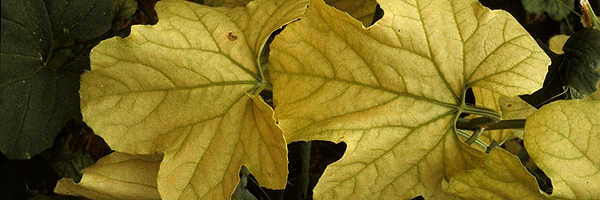
Beet pseudo-yellows virus (BPYV)
(Crinivirus, Closteroviridae)
BPYV is a crinivirus transmitted by whitefly in the mode semi-persistent . It is mostly found in sheltered crops where it causes like symptoms yellowing. Described in California in 1965, it was first reported in France on melon in the early 1980s, when large populations of its vector, the whitefly were also observed in greenhouses Trialeurodes vaporariorum, . BPYV appears to be more common in spring crops.
BPYV multiplies in the phloem of infected plants which disrupts the circulation of nutrients in the plant and causes an induced deficiency which is expressed by yellowing of the leaves. The difficulties in studying this type of disease transmissible only by whitefly or by grafting have led to some confusion in the precise identification of the virus responsible for these symptoms. Thus, it has been reported in several countries around the world under different names: Melon yellows virus and Cucumber chlorotic spot virus in France and Spain, Cucumber infectious chlorosis virus in Bulgaria, Cucumber yellows virus in Holland and Japan. It is only recently that molecular studies have shown that all of these viruses are in fact strains of BPYV.
BPYV has very flexible particles of approximately 800 x 12 nm. Its genome is divided into two components of positive single-stranded RNA.
Initially, BPYV was diagnosed by laborious testing for transmission by its vector T. vaporariorum . The convergence of symptoms caused by the Beet pseudo-yellow virus (BPYV), Cucurbit yellow stunting disorder virus (CYSDV) and Cucurbit Aphid Borne Yellows Polerovirus (CABYV) indeed prevents a reliable diagnosis based on the symptoms of jaundice alone. These three viruses are transmitted by different vectors: T. vaporariorum (BPYV), Bemisia tabaci (CYSDV) or aphids (CABYV). Pullulations of one of these vectors associated with symptoms of jaundice can then guide the diagnosis. The progress made in the characterization of the BPYV genome has made it possible to define specific primers allowing a diagnosis by RT-PCR. It is a very unstable virus, not very concentrated and very difficult to purify, which has not made it possible to obtain, by conventional methods, an antiserum which can be used in ELISA. However, thanks to molecular biology techniques, it was possible to synthesize the BPYV capsid * protein by a bacterium and to use this preparation to obtain an antiserum which can be used in DAS-ELISA.
* The capsid protein is a protein which protects the nucleic acid and which therefore is the main constituent of the viral particle. It is this which is detected by the DAS-ELISA tests.





